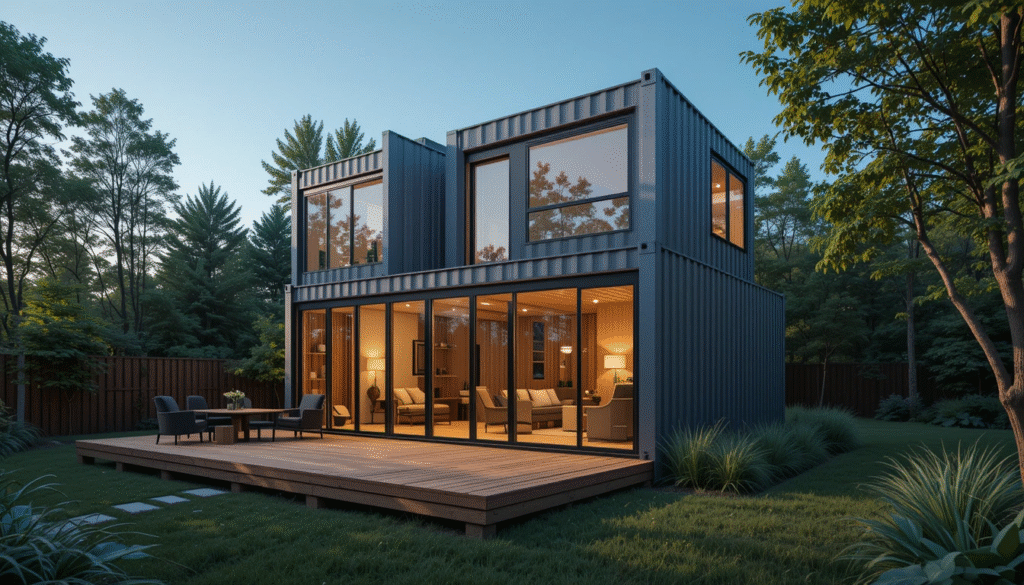Phone:
(701)814-6992
Physical address:
6296 Donnelly Plaza
Ratkeville, Bahamas.

Let’s face it-buying a home in America isn’t what it used to be. Prices are climbing, space is shrinking, and the dream of homeownership feels further out of reach for many. But there’s a new solution gaining ground, offering affordability, sustainability, and creativity all in one package: container homes.
What used to be large steel boxes transporting goods across oceans are now being transformed into cozy, stylish, and efficient living spaces. From first-time homeowners to off-grid adventurers, more Americans are jumping on the container home bandwagon.
So, what are container homes exactly? How much do they cost? Are they really livable and legal? Let’s break it all down.
🍓 Click Here to Buy Tiny homes 🥃✨
🛒🍓 Grab Your Tiny homes Now! 🥂💎
🍹🍓 Enjoy the Sweetness – Buy Tiny homes Today! 🛍🔥
Container homes are residences built from steel shipping containers. These containers are strong, uniform in size, and widely available. Most homes are made from 20-foot or 40-foot containers, either used individually or combined to create larger, more elaborate layouts.
These containers are retrofitted with everything you’d find in a traditional home-plumbing, electrical, insulation, doors, windows, and finishes-making them a fully functional alternative to stick-built housing.
The best part? They’re versatile. You can design anything from a minimalist tiny home to a two-story family residence or even a modern Airbnb rental.
Let’s talk money. The average price of a home in the U.S. is well over $400,000 in many areas. A basic container home, by contrast, can cost anywhere from $30,000 to $100,000, depending on size and customization. That’s a huge difference-especially for first-time buyers, retirees, or those looking to downsize.
Building a traditional home can take 6 months to over a year. But a container home? It can often be built in 8 to 12 weeks, sometimes even faster if you go with a prefab or modular design. That means less stress and less time waiting for your home to be ready.
Container homes are a win for the environment. You’re recycling steel that would otherwise sit unused or end up in a junkyard. Many people pair container homes with solar panels, rainwater collection, and energy-efficient appliances to create a truly sustainable lifestyle.
If you think “container home” means living in a dull metal box-think again. With the right planning and design, these homes can be incredibly beautiful. Picture sleek modern kitchens, open-concept layouts, rooftop decks, wood-paneled exteriors, and large glass doors opening to scenic views.
While container homes come with some exciting benefits, they’re not without their challenges. Here are a few things you should keep in mind:
Not all areas in the U.S. allow container homes. Zoning laws, building codes, and HOA regulations can vary wildly from one county or city to another. Before buying land or hiring a builder, check local regulations. Rural areas tend to be more flexible than suburban or urban ones.
Steel gets hot in the summer and cold in the winter. Without proper insulation, a container home can be uncomfortable year-round. Luckily, options like spray foam and rigid board insulation make it easy to regulate temperature effectively.
Cutting into the container to add windows, doors, or combine multiple units requires careful engineering. You’ll want experienced professionals to handle the structural changes and reinforcement.
Some banks and insurers still see container homes as “non-traditional,” which can make it harder to get a mortgage or coverage. That’s changing slowly as the market grows, but you may need to work with specialized lenders and insurers.

Container homes appeal to a wide range of people, including:
Whether you want a permanent residence, a vacation home, or an off-grid retreat, container homes are flexible enough to fit just about any lifestyle.
Here’s a general breakdown of what you might spend on a container home:
| Component | Estimated Cost |
|---|---|
| Used 20ft Container | $2,000–$4,000 |
| Used 40ft Container | $3,000–$6,000 |
| Interior Build-Out | $20,000–$60,000 |
| Electrical/Plumbing | $5,000–$15,000 |
| Insulation & Climate Control | $5,000–$10,000 |
| Site Prep & Foundation | $3,000–$10,000 |
| Permits & Fees | $1,000–$5,000 |
| Total Cost (Basic Home) | $30,000–$100,000+ |
Costs can vary based on materials, labor, land prices, and customization. A multi-container home with designer finishes could run up to $200,000 or more, but it’s still far more affordable than many traditional homes.
Absolutely. Shipping containers are made from corrugated steel and are designed to withstand harsh weather, stacking pressure, and long-distance travel. When properly modified and installed, container homes are just as safe as traditional houses-and often more resistant to storms and natural disasters.
Unfortunately, no. You’ll need to check with your local zoning office or building department. Some places welcome alternative housing, especially rural or off-grid communities, while others have strict building codes that may limit or prohibit container homes.
With proper maintenance, a container home can last 30 to 50 years or more. Painting, sealing against rust, and good insulation help extend the lifespan. The steel shell is incredibly durable-just make sure you’re keeping up with basic upkeep.
Yes, but it can be tricky. Some banks and credit unions offer construction loans or personal loans for container homes. You may also find lenders who specialize in alternative or tiny homes. As container living becomes more popular, financing options are becoming more widely available.
Container homes offer a unique blend of affordability, efficiency, and creativity. Whether you’re fed up with overpriced real estate or just want to simplify your life, this modern housing trend provides a smart, sustainable option for Americans of all ages.
If you’re open to thinking outside the box-literally-you might find that container living is exactly what you’ve been looking for.